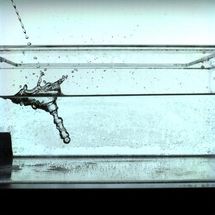The Tao of pee
2 presentations at the upcoming APS Division of Fluid Dynamics Meeting in Pittsburgh explore the science behind urination
Although we don't often think about it, fluid dynamics touches almost every aspect of our lives, from a billowing breeze that buffets a flag, to swirling river currents that shape canyons to the surging blood that sustains our lives. One of the basest of bodily functions -- urination -- is governed primarily by the equations of fluid motion.

This is the Georgia Tech team working at the zoo.
David Hu/Georgia Tech

Under average urinal conditions a typical male urine stream breaks up into droplets before it makes contact with the urinal.
BYU/Chris Mabey, Randy Hurd and Tadd Truscott

This shows the dramatic water entry of a simulated male urine stream impacting a water surface and opening a large, interesting cavity with multiple ridges. Each droplet forms a small cavity wherein the next droplet can pass and form an additional cavity creating a chain of small cavity structures.
BYU/Randy Hurd and Tadd Truscott



In the laboratory of Georgia Tech's David Hu, scientists and engineers look to nature for engineering ideas. In work that could help in the design of scalable hydrodynamic systems, researchers from the Hu lab recently filmed the urination habits of 16 animals of varying sizes – five mice, five rats, one dog, two goats, two cows, and one elephant. The results? Size matters. Although small animals such as mice and rats take about 2 seconds to pee, urination "events" in animals larger than about 5 kilograms consistently clocked in at an average of 21 seconds.
"An elephant has a large bladder and a urethra with dimensions comparable to a household pipe," says graduate student and study leader Patricia Yang. As gravity pulls fluid down to the bottom of the urethra, Yang explains, the flow speed increases, causing urine to be eliminated more quickly than in a medium-sized animal, like a dog, which has a shorter urethra and gets less of a boost from gravity. The dog, however, has a smaller bladder, and "this is why an elephant and a dog empty their bladder in the same time," she says.
When it comes to urination accuracy, however, speed and size are less important than angle, says fluid dynamicist Randy Hurd of Brigham Young University, who will present a study of the dynamics of urinal use. Hurd and his graduate advisor, Tadd Truscott, got the idea for the work during a caffeine- and sugar-fueled midnight road trip from San Diego following last year's DFD meeting. The two were brainstorming about new and creative projects for Truscott's "Splash Lab," which uses high-speed imaging techniques to study fluid behavior.
At the Splash Lab, Hurd and his colleagues created an artificial male urethra on a 3D printer. The urethra – a cylinder with a 8 mm x 3 mm elliptical channel running down the center – was attached with tubing to a pressurized container, allowing it to deliver a steady stream of dyed water at 21 milliliters per second, the expected flow rate for a healthy, middle-aged male. High-speed cameras were used to visualize the flow as it struck both a solid surface (representing the porcelain back wall of most urinals) and a "free" surface (representing standing water); white paper was placed below the surfaces to track where splash droplets ended up.
Perhaps not surprisingly, the researchers found that it is indeed possible to use a urinal without splashing onto yourself or your own clothing. The key? Angle.
"For typical male urination, the stream breaks up into droplets before impacting the urinal wall or the water surface," he says. Significant splash-back occurs if that stream is angled perpendicular to the urinal wall, down to angles of about 45 degrees. But when this impact angle becomes very small, "it is much easier for the droplets to only slightly change direction, and slide along the porcelain surface without generating large splashes," says Hurd, who hopes to eventually create an optimization function to find the ideal approach for urinal usage.
"Although reducing the impact angle would also work in traditional toilets, these angles tend to only present themselves around the rim of the bowl, simultaneously increasing the chances of missing the bowl entirely," says Hurd. "I wouldn't recommend this approach to anyone but military snipers."























































